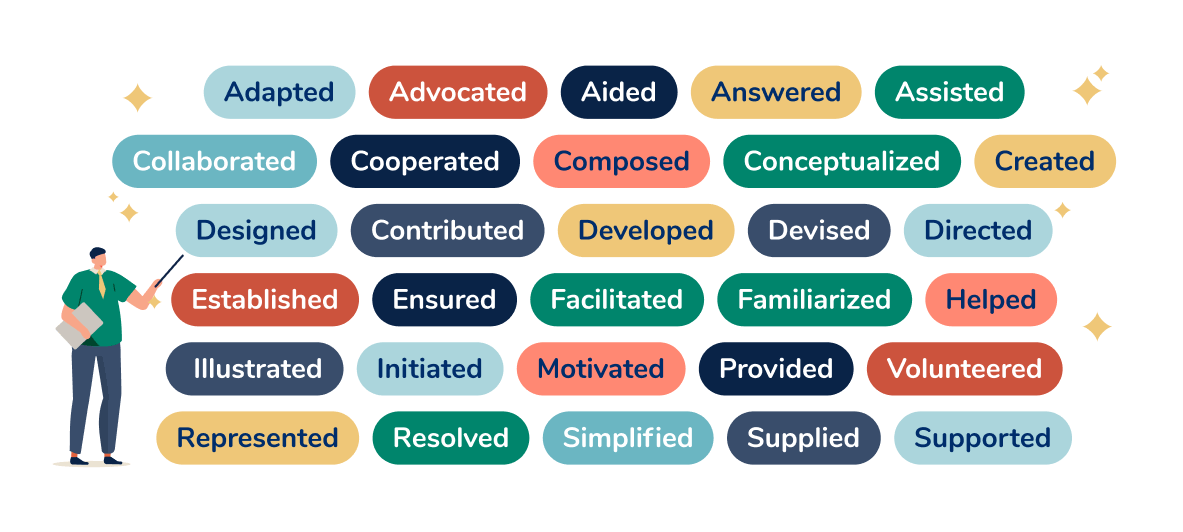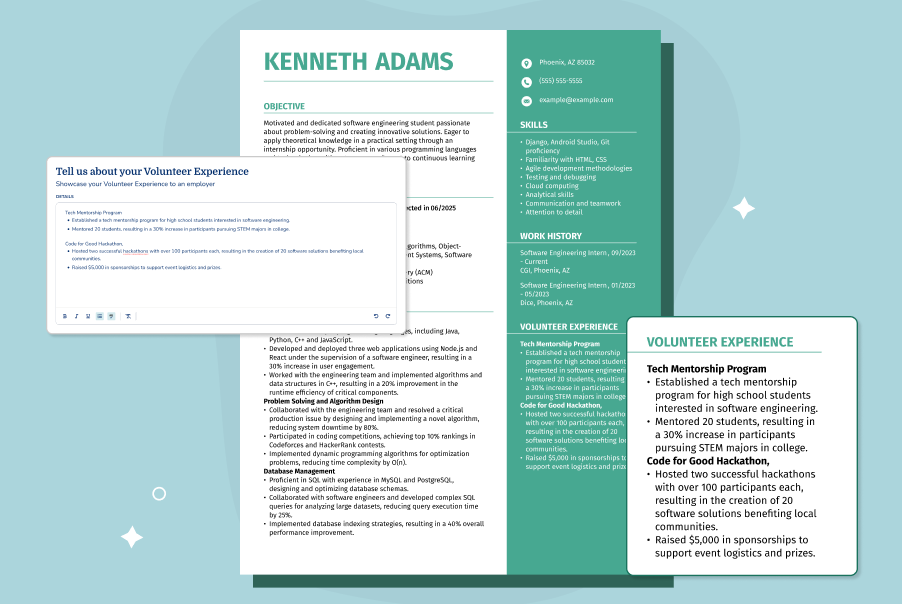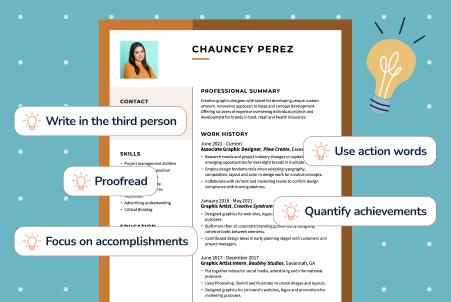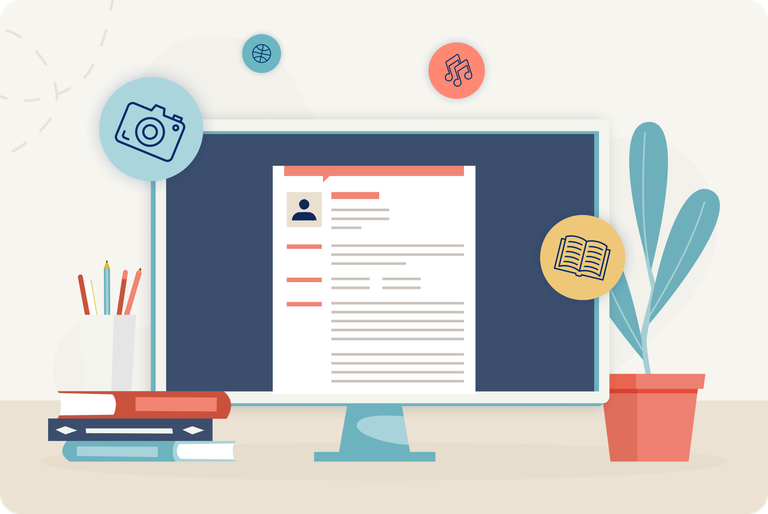How to Write a Resume With No Experience: Examples & Guide

Our customers have been hired at: *Foot Note
No work experience? No problem! Everyone needs a resume for their first job, but how do you write one with no work experience? We’re here to show you!
Writing a basic resume with no work experience is easy once you have the tools to effectively highlight your strengths and match them to each role you’re applying for.
Follow our step-by-step guide and learn how to create a job-winning resume directly from your phone, tablet, or computer. Before we start, take a look at this no-experience resume example:
How to Make a Resume for a First Job
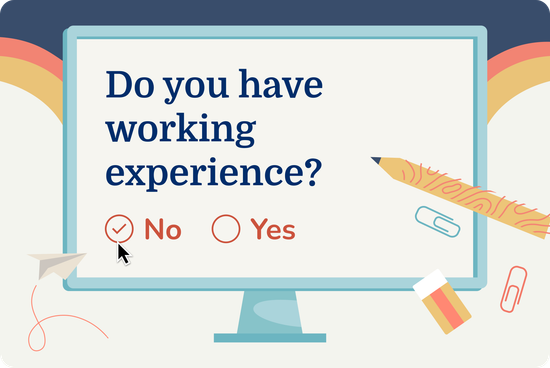
When creating a resume with no prior work experience, focus on your skills, education, and relevant accomplishments from internships, class projects, courses, volunteer experiences, and extracurricular activities. Let’s explore how to create a resume with no experience.
STEP 1Choose a format for your first resume
Here’s a secret many first-time job seekers don’t know about making a resume without experience: choosing a suitable resume format can significantly improve your chances of landing interviews and ultimately securing a job offer.
We recommend the functional resume format for a beginner resume because it emphasizes skills over work experience.
Plus, many functional resume templates offer flexibility in how you display your job qualifications. For example, you can arrange your skills into categories to highlight the most relevant skills for each job and place your education at the top instead of the bottom of your resume.
STEP 2Select a professional resume template
Writing a resume with no work experience can feel daunting. That’s why resume templates are incredibly useful tools for writing a first resume.
They make it easier to craft a professional resume because they provide a framework for your information, helping to organize your thoughts and display your qualifications.
What’s more, resume templates save time, ensuring your resume is formatted correctly, ATS-friendly, and visually appealing. This way, you can focus on tailoring your resume for the job you want. See how to make an ATS-friendly resume for additional tips and tricks.
STEP 3Prepare your information
Having your job information ready will save you time in the long run, so you can confidently put your best foot forward. To prepare your beginner resume, review the job description carefully and note the requirements.
Then, think carefully and honestly about what you offer; you might be surprised! You could discover that you picked up skills and work experience through activities such as:
- School activities such as sports or the school orchestra.
- Clubs or organizations, like the student council or a college sorority/fraternity.
- Community activities, such as volunteering at a soup kitchen.
- Hobbies like writing, photography, or leading a neighborhood group.
As you reflect on your experiences, make note of awards, honors, and other significant accomplishments like graduating Magna Cum Laude or achieving the title of student body president.
Consider the skills you gained through those experiences, especially transferable skills such as research, organization, and teamwork, and interpersonal skills like communication and active listening, which are useful beginner skills for a resume.
Next, match all those skills and experiences you have acquired and your unique personality with the job requirements.
STEP 4Add your contact information
When you make a resume with no experience, include a header with contact information so recruiters and potential employers can reach you. Consider adding a resume headline under your name to boost your resume.
It’s imperative that your contact information is professional, up to date, and easy to find. Include the following information:
- Full name
- Phone number
- Professional email address
- City and ZIP code
- Professional profile, website, or portfolio
STEP 5Highlight your strengths in your objective
Start strong with a resume objective that explains your goals for the job and highlights some of your job-relevant skills. Here’s an example of a no-experience resume objective:
Dedicated recent graduate with a bachelor’s degree in education, seeking a first-time teaching position to apply my passion for teaching, knowledge of curriculum development, and strong communication skills in the classroom. Eager to support students’ academic and personal growth by creating an engaging and inclusive learning environment. Committed to employing innovative teaching methods and fostering a positive and collaborative atmosphere to help all students succeed.
Notice how this example objective for a resume with no experience displays a mix of hard (curriculum development), soft (communication skills), and technical skills (innovative teaching methods).
It also tells the potential employer exactly what the job applicant’s goals are: “Eager to support students’ academic and personal growth….”
Explore our library of student resume examples and templates for ideas on how to write a resume objective for a student resume.
STEP 6Make a skills section
Focus on five to 10 relevant skills in your resume skills section. This way, you’re emphasizing your qualifications without overwhelming the recruiter or hiring manager.
Customize your skill section to match the job requirements. Take this sample resume skills section, for instance:
SKILLS
Software development
- Coding (C++, Java, Python, CSS)
- Basic testing procedures
- Cryptography
- Cloud platforms
Soft skills
- Times management
- Problem-solving
- Teamwork
Browse our collection of resume examples for more ideas about how to write a resume with no job experience. You’re sure to find several resume examples for a first job to inspire you!
STEP 7Emphasize your education
Display your educational background prominently to emphasize your readiness for the job. Highlight relevant coursework, academic awards and honors, scholarships, or participation in study abroad programs in this section. Your education section should look like this:
EDUCATION
Bachelor of Science in Media Writing, Dickinson College, Carlisle, PA – 2012-2016
- Graduated magna cum laude
- 3.95 GPA
- University Honors
STEP 8Add a section for licenses and certifications if needed
If you are working toward or have specialized certifications and licenses for a job like nursing, accounting or teaching, you can create a separate section on your resume labeled “Licenses and Certifications” and place it just below your education section.
Create a bullet point for every license or certification you have and list them in reverse-chronological order, including:
- The title of the certification, course, or license.
- The name of the certifying agency or body.
- The date you obtained each certificate.
- The expiration date of your certificate, if applicable. If you have not yet finished the course, write “In progress” and the expected date of completion.
Here’s an example of an effective certifications section:
CERTIFICATIONS
CPR Certificate
American Red Cross, October 2021
Expires: October 2023
STEP 9Add relevant experience
The trick to filling out a first job resume work experience section is to think of work experience in broader terms. Look at your notes, and you will probably find at least one experience to add.
Relevant work experience can come from:
- Internships
- Student teaching
- Coaching or mentoring
- A role in a student organization
- Community service
- Volunteer experience
- A personal project
Hiring managers want to know your contributions. For each experience you add to your first resume, add one to three bullet points that highlight measurable accomplishments.
For even more impact, start every bullet point with an action verb. For example, “Implemented a new customer feedback system, resulting in a 20% increase in overall customer satisfaction scores within the first three months of its launch.”
Here are some action words you can include in your resume:
STEP 10Add optional sections to enhance your resume
If you have room on a one-page resume, don’t be shy! Show off your academic or community awards, scholastic honors or scholarships, personal or school projects, language proficiency and job-relevant hobbies. Here’s a for an optional awards section:
AWARDS
- George Polk Award for National Reporting (2020)
- Conscience-in-Media Award (2018)
- Clio Awards (2016)
Browse our collection of high school resume templates and examples for additional samples and tips to guide your writing process.
STEP 11Proofread your first resume
Typos and grammatical errors are the most common and costly mistakes.
After you finish writing your resume, proofread it more than once and ask someone else to check it for you before sending it to a potential employer.
STEP 12Save your resume
Making a resume with no experience is about more than how you organize and write it. A polished first-job resume means you also have to name your document professionally and save it in an appropriate file format for the job.
To save your resume, check the job description for the best file type. If a file type is not requested, .doc or .docx are safe choices because most ATS can read Microsoft Word files, and most companies prefer them. Use this formula to name your resume: Your Name-Job Title-Resume-Company Name-Date.
Use this handy checklist to ensure you have everything you need in your resume:

Take Your Resume to the Next Level
Our builder can help you elevate your first resume with professional templates and content suggestions tailored to your target role.
No Experience Resume Templates & Examples
Food service no experience template
Retail no experience template
Flight attendant no experience template
Security guard no experience template
Babysitter no experience template
Accountant no experience template
Bartender no experience template
Software developer no experience template
Marketing no experience template
Web developer no experience template
Resume Formatting Tips
To start, here are some basic formatting tips to ensure your resume looks polished and professional, as well as easily readable:
- Set margins to 1 inch on all sides of your document.
- Choose an appropriate resume font type and size and stick to it throughout your resume. Good font choices are Arial, Calibri, Helvetica, and Times New Roman in 12-point size.
- Ensure proper spacing between sections of your document. The best practice is to use a single space, but adding extra space between section headers and section body text can sometimes look better, depending on font type and how much content you add to your resume.
- Left-align your page content.
- Use bullet points to emphasize your skills and achievements.
Create a Cover Letter for Your First Job
Landing a job interview takes more than a perfect first job resume. If you want to beat the competition, you need a strong cover letter to complement your resume.
Writing a strong cover letter shows motivation and allows you to tell employers more about your background than a resume can, a bonus for first-job applicants.
Use a cover letter as a chance to introduce yourself and connect with prospective employers by telling them why you want the job and why you are the best match for it.
We can show you how to write a cover letter inspired by our professional cover letter examples. When you’re ready, choose a template and use our Cover Letter Generator to effortlessly make a professional cover letter with no experience.
Key Takeaways
Now you know how to build a resume with no experience! But before you run off to build the perfect resume and cover letter, take these key points about writing a resume with no experience:
- The functional resume format is the best option to make a resume with no experience because it highlights your relevant skills over work experience.
- When creating a resume with no job experience, transferable skills are your best friends.
- Most companies use ATS to screen resumes, which can only read resumes with standard formatting.
- Add optional resume sections like awards or important coursework if they apply to you, and you can’t fit them into other sections of your resume.
- A resume template, combined with our Resume Builder, is the easiest and fastest way to make a resume with no experience.
FAQ
Should I use a resume template?
If you want to write a resume for a job with no experience quickly and easily, a beginner resume template is the way to go.
Templates organize your qualifications in a way that ATS can understand and potential employers can read easily. Templates also make it easy to tailor your resume for every job, and they add style to your no-experience resume with professional designs.
When you use one of our resume templates with our Resume Builder, you’ll get professionally written suggestions for every section of your resume, eliminating guesswork.
Plus, you can edit your resume as you go along and after you proofread it. You will be able to create and send your no-experience resume in minutes.
Which skills should I include in a student resume with no job experience?
If you are a student, display a mix of skills and focus on transferable skills that apply to any job title and industry. Top skills for a beginner resume in 2025 include:
- Interpersonal skills
- Creativity
- Collaboration
- Problem-solving
- Innovation
- Leadership
- Verbal and written communication
- Active listening
- Analytical thinking
- Intercultural competence
- Flexibility
- Time management
- Customer service
- Attention to detail
- Tech savviness
- Critical thinking
- Initiative
Review our high school student resume examples for ideas on how to add your skills to your resume effectively.
Should I put references on a no-experience resume?
Have a separate reference list on hand, but save the extra space on your resume for details about your qualifications. If a hiring manager wants references, they will let you know.
How do I write a resume as a teenager with no job experience?
If you’re applying for your first job as a teenager, we recommend looking at our teen resume examples to get started.
As with any resume, you’ll start with your contact information, a resume objective, and then choose to prioritize either your education, your skills, or any extracurricular activities. Even without having a job before, there’s a lot of experience in school, volunteering, sports, and more.
Add your responsibilities and accomplishments in any role you’ve had, as some of these will apply to most jobs, such as making inventory, planning school events, or organizing study groups.
Rate this article
How to Write a Resume With No Experience: Examples & Guide
4/5 stars with 451 reviews

Kellie Hanna
Career Advice Writer
Kellie is a career advice writer. She is committed to helping job seekers navigate the job market and succeed in their careers.
More Articles by Kellie HannaOur customers have been hired at:*Foot Note
